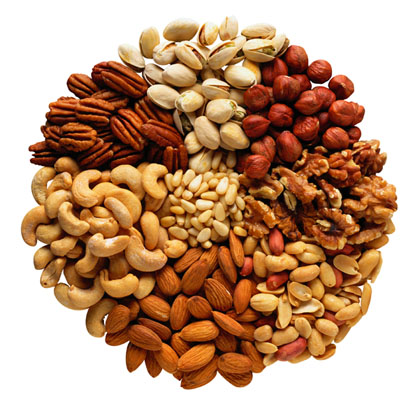We’re so thrilled that today is the true release date of our book, Primal Cravings. Books will begin shipping today from Amazon and can be found online and in local Barnes and Nobles. Are you like us and want a peek at the book before purchasing? You can search by your zip code on B&N to see if the book is in stock near you. We’d be truly grateful to those who would take the time to review the book in either place. It’s a scary thing to ask people to judge you, but judge away.
So we’ve made a big deal about eliminating almond flour in our book. Several have written to inquire as to why. We wanted to take a moment to comment here on our decision to bake with non-almond methods and link to some great articles discussing why it’s likely prudent to moderate nut consumption.

Reason #1
Health
Nuts are great, don’t get us wrong. But one of the main tenets generally promoted by adherents to paleo/Primal diets is reducing omega-6 intake, as well as other potential toxins…right? We bash wheat, peanuts and soy, and all industrial seed oils citing these reasons…so we have to also realize that many nuts contain large amounts of omega-6 and phytic acid as well. Most of them contain some omega-3 as well, but generally the 6:3 ratio is heavily leaning on the 6 side (macadamias are the best).
Omega-6 Content Various Nuts (1/4 cup)
Walnuts – 9.5 g
Almonds – 4.36 g
Cashews – 2.6 g
Macadamias – 0.5 g
Brazil nuts – 7.2 g
Hazelnuts – 2.7 g
Pistachio – 4.1 g
Pine nuts – 11.6 g
Pecans – 5.8 g
Now multiply the almond number by 8, because most almond flour recipes call for around 2 cups.
To some this won’t be new. There’s been a growing understanding recently that abusing nuts probably isn’t wise. Now, they do come with great micro-nutrition and are likely beneficial in moderate amounts. But in huge amounts and especially in a less-than-whole form, the omega-6 in almond flour is likely prone to oxidation and the increased omega-6 is inflammatory. Omega-6’s propensity to be inflammatory lies in the fact that inflammatory eicosanoids (bodily signaling molecules) are derived from it. Nuts (especially almonds) also contain phytic acid which blocks absorption of other dietary minerals. Phytic acid can be reduced by soaking/sprouting…but let’s be realistic here…that is a pain in the butt.
Read more about this at Mark’s Daily Apple and Chris Kresser.
Reason #2
Expensive
Almond flour is almost 3x the price of tapioca flour. $35 for 5 lbs or $15 for 6 lbs? You do the math. We combine tapioca flour and coconut flour (this one and this one), in certain proportions and with certain other ingredients, depending on what the end-product is going to be: pastry crust, muffin batter, etc. We use way less actual ‘flour’ in our baking recipes than the numerous cups called for in traditional almond flour recipes.
Reason #3
Deliciousness
Let’s be honest, without deliciousness does any of this really even matter? What would be the point of getting rid of almond flour only to make something no one would want to eat anyway? We use nuts in the book when we want the flavor of the nuts, and in that context they can certainly be beneficial to health. But when we blanch them down…and try to mask the flavor of them to make neutral breads and baked goods…we’re not using them as nuts…we’re just trying to use them as a blank canvas of crispy, crunchy goodness. We have done that in the past…and again…occasionally, surely this can be done healthily. But when we set out to write the book, we thought it would be outstanding if we could create that same crispy, crunchy goodness without having to use almond flour. We felt we could really mitigate one of the big concerns with primal baking (see Reason #1) but it had to be tasty.
It took a long time and we had to painfully trash many, many, many attempts (like 30). But when we finally succeeded we couldn’t have been more pleased with the results. Not only had we reduced the omega-6 and phytic acid content and reduced the cost; we were ecstatic to discover that we had a tastier product as well. We got a better texture, crumb, moistness; respective to what we were going for than what we’d ever been able to achieve with almond flour. One Amazon reviewer even told us that her kids loved the goodies and would never touch a non-traditional version before.
You’d be nuts not to buy this book. 🙂
Leave a Reply